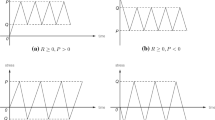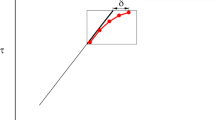Abstract
The objective of this study is two-fold. Firstly, new finite strain elastoplasticity models are proposed from a fresh standpoint to achieve a comprehensive representation of thermomechanical behavior of metals and alloys over the whole deformation range up to failure. As contrasted with the usual elastoplasticity models, such new models of much simpler structure are totally free, in the sense that both the yield condition and the loading—unloading conditions need not be introduced as extrinsic coercive conditions but are automatically incorporated as inherent constitutive features into the models. Furthermore, the new models are shown to be thermodynamically consistent, in a further sense that both the specific entropy function and the Helmholtz free energy function may be presented in explicit forms, such that the thermodynamic restriction stipulated by Clausius—Duhem inequality for the intrinsic dissipation may be identically satisfied. Secondly, it is then demonstrated that the thermo-coupled fatigue failure behavior under combined cyclic changes of stress and temperature may be derived as direct consequences from the new models. This novel result implies that the new model can directly characterize the thermo-coupled fatigue failure behavior of metals and alloys, without involving any usual damage-like variables as well as any ad hoc additional criteria for failure. In particular, numerical examples show that, under cyclic changes of temperature, the fatigue characteristic curve of fatigue life versus temperature amplitude may be obtained for the frst time from model prediction both in the absence and in the presence of stress. Results are in agreement with the salient features of metal fatigue failure.
Similar content being viewed by others
References
L Pook, Metal Fatigue, Springer, Berlin, 2007.
Walker, K.P., Research and development program for non-linear structural modeling with advanced time-temperature dependent constitutive relationships. NASA CR-165553, 1981.
Swanson, G., Linask, I., and Nissley, D., Life prediction and constitutive models for engine hot section anisotropic materials program. NASA CR-174952, 1986.
P.L.C. Rolls-Royce, Predictive methods for combined cycle fatigue in gas turbine blades, in: European (Sixth RTD Framework Programme) Project, London, 2011.
J.W. Hutchinson, A.G. Evans, Mechanics of materials: top-down approaches to fracture, Acta Mater. 48 (2000) 125–135.
B.N. Cox, H.J. Gao, D. Gross, D. Rittel, Modern topics and challenges in dynamic fracture, J. Mech. Phys. Solids 53 (2005) 565–596.
D. Krajcinovic, Damage Mechanics, Elsevier, Amsterdam, 2003.
M. Brünig, A continuum damage model based on experiments and numerical simulations—a review, in: H. Altenbach, T. Matsuda, D. Okumura (Eds.), From Creep Damage Mechanics to Homogenization Methods—A Liber Amicorum to Celebrate the Birthday of Nobutada Ohno, Advanced Structural Materials Series, Springer, Berlin, 2015, pp. 19–35.
S. Suresh, second ed, Fatigue of Materials, Cambridge University Press, Cambridge, 1998.
N.E. Frost, K.J. Marsh, L.P. Pook, Metal Fatigue, Dover Publications, Inc., New York, 1999.
H. Xiao, Thermo-coupled elastoplasticity model with asymptotic loss of the material strength, Int. J. Plast. 63 (2014) 211–228.
V. Firouzdor, M. Rajabi, E. Nejati, F. Khomamizadeh, Effect of microstructural constituents on the thermal fatigue life of A319 aluminum alloy, Mater. Sci. Eng. A 454 (2007) 528–535.
Y.D. Huang, N. Hort, H. Dieringa, P. Maier, K.U. Kainer, Investigations on thermal fatigue of aluminum-and magnesium-alloy based composites, Int. J. Fatigue 28 (2006) 1399–1405.
Y.G. Min, J. Bergström, X.C. Wu, L.G. Xu, Oxidation and thermal fatigue behaviors of two type hot work steels during thermal cycling, J. Iron Steel Res. Int. 20 (2013) 90–97.
J. Jonas, B. Ilja, J. Erland, D. Rainer, L. Peter, Investigation on thermal fatigue of SnAgCu, Sn100C, and SnPbAg solder joints in varying temperature environments, Microelectron. Reliab. 54 (2014) 2523–2535.
F. Szmytka, M. Salem, F. Rézaï-Aria, A. Oudin, Thermal fatigue analysis of automotive diesel piston: experimental procedure and numerical protocol, Int. J. Fatigue 73 (2015) 48–57.
F. Ohmenhäuser, C. Schwarz, S. Thalmair, H.S. Evirgen, Constitutive modeling of the thermo-mechanical fatigue and lifetime behavior of the cast steel 1.4849, Mater. Des. 64 (2014) 631–639.
T. Seifert, H. Riedel, Mechanism-based thermomechanical fatigue life prediction of cast iron. Part I: Models., Int. J. Fatigue 32 (2010) 1358–1367.
E. Paffumi, K.F. Nilsson, Z. Szaraz, Experimental and numerical assessment of thermal fatigue in 316 austenitic steel pipes, Eng. Failure Anal. 47 (2015) 312–327.
L. Rémy, F. Szmytka, L. Bucher, Constitutive models for bcc engineering iron alloys exposed to thermal-mechanical fatigue, Int. J. Fatigue 53 (2013) 2–14.
K. Bauerbacha, M. Vormwalda, J. Rudolph, Fatigue assessment of thermal cyclic loading conditions based on a short crack approach, Proc. Eng. 2 (2013) 1569–1578.
V. Levitin, High Temperature Strain of Metals and Alloys, Wiley-VCH Verlag GmbH & Co. KGaA, Weinheim, 1996.
R.C. Reed, The Superalloys: Fundamentals and Applications, Cambridge University Press, Cambridge, 2006.
K. Otsuka, C.M. Wayman, Shape Memory Materials, Cambridge University Press, Cambridge, 1998.
J.F. Bell, The experimental foundation of solid mechanics, Encyclopedia of Physics, vol. VIa/1, Springer, Berlin, 1973.
Y.L. Bai, B. Dodd, Adiabatic Shear Localization, Pergamon, London, 1992.
H. Xiao, O.T. Bruhns, A. Meyers, Free rate-independent elastoplastic equations, ZAMM-J. Appl. Math. Mech. 94 (2014) 461–476.
Z.L. Wang, H. Xiao, A study of metal fatigue failure as inherent features of elastoplastic constitutive equations, in: H. Altenbach, T. Matsuda, D. Okumura (Eds.), From Creep Damage Mechanics to Homogenization Methods-A Liber Amicorum to Celebrate the Brithday of Nobutada Ohno, Advanced Structural Materials Series, Springer, Berlin, 2015, pp. 529–540.
 , 2016,37(2): 245–251 Z.L. Wang, H. Xiao, X.M. Wang, Direct simulation of metal fatigue failure based on new elastoplastic model, Chin. Q. Mech. 37 (2) (2016) 245–251.
, 2016,37(2): 245–251 Z.L. Wang, H. Xiao, X.M. Wang, Direct simulation of metal fatigue failure based on new elastoplastic model, Chin. Q. Mech. 37 (2) (2016) 245–251.H. Xiao, O.T. Bruhns, A. Meyers, Elastoplasticity beyond small deformations, Acta Mech. 182 (2006) 31–111.
O.T. Bruhns, H. Xiao, A. Meyers, Self-consistent {E}ulerian rate type elasto-plasticity models based upon the logarithmic stress rate, Int. J. Plast. 15 (1999) 479–520.
O.T. Bruhns, H. Xiao, A. Meyers, Some basic issues in traditional Eulerian formulations of finite elastoplasticity, Int. J. Plast. 19 (2003) 2007–2026.
O.T. Bruhns, H. Xiao, A. Meyers, A weakened form of Ilyushin’s postulate and the structure of self-consistent Eulerian finite elastoplasticity, Int. J. Plast. 21 (2005) 199–219.
H. Xiao, O.T. Bruhns, A. Meyers, The choice of objective rates in finite elastoplasticity: general results on the uniqueness of the logarithmic rate, Proc. R. Soc. London, Ser. A 456 (2000) 1865–1882.
H. Xiao, O.T. Bruhns, A. Meyers, A consistent finite elastoplasticity theory combining additive and multiplicative decomposition of the stretching and the deformation gradient, Int. J. Plast. 16 (2000) 143–177.
H. Xiao, O.T. Bruhns, A. Meyers, Thermodynamic laws and consistent Eulerian formulations of finite elastoplasticity with thermal effects, J. Mech. Phys. Solids 55 (2007) 338–365.
H. Xiao, O.T. Bruhns, A. Meyers, Logarithmic strain, logarithmic spin and logarithmic rate, Acta Mech. 124 (1997) 89–105.
H. Xiao, Pseudo-elastic hysteresis out of recoverable finite elastoplastic flows, Int. J. Plast. 41 (2013) 82–96.
H. Xiao, An explicit, direct simulation of multi-axial finite strain inelastic behavior for polymeric solids, Int. J. Plast. 71 (2015) 146–169.
H. Xiao, O.T. Bruhns, A. Meyers, Finite elastoplastic J2 -flow models with strain recovery effects, Acta Mech. 210 (2010) 13–25.
H. Xiao, O.T. Bruhns, A. Meyers, Phenomenological elastoplasticity view on strain recovery loops characterizing shape memory materials, ZAMM-J. Appl. Math. Mech. 90 (2010) 544–564.
H. Xiao, O.T. Bruhns, A. Meyers, Thermo-induced plastic flows and shape memory effects, Theor. Appl. Mech. 38 (2011) 155–207.
H. Xiao, An explicit, straightforward approach to modeling SMA pseudo-elastic hysteresis, Int. J. Plast. 53 (2014) 228–240.
Author information
Authors and Affiliations
Corresponding author
Rights and permissions
About this article
Cite this article
Wang, Z., Li, H., Yin, Z. et al. A new, direct approach toward modeling thermo-coupled fatigue failure behavior of metals and alloys. Acta Mech. Solida Sin. 30, 1–9 (2017). https://doi.org/10.1016/j.camss.2016.10.001
Received:
Accepted:
Published:
Issue Date:
DOI: https://doi.org/10.1016/j.camss.2016.10.001





 , 2016,37(2): 245–251 Z.L. Wang, H. Xiao, X.M. Wang, Direct simulation of metal fatigue failure based on new elastoplastic model, Chin. Q. Mech. 37 (2) (2016) 245–251.
, 2016,37(2): 245–251 Z.L. Wang, H. Xiao, X.M. Wang, Direct simulation of metal fatigue failure based on new elastoplastic model, Chin. Q. Mech. 37 (2) (2016) 245–251.